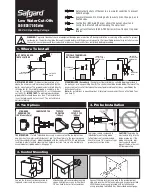
English
12
Wilo AG 05/2005
• Excavate the trench (Fig. 2).
- Excavate the trench to a depth of (H + X – Y),
X 200 mm, Y 100 mm.
- Introduce the sand bed (not cohesive, particle
range 0-32 mm, minimum bed thickness
X 200 mm) and compact and level until a trench
depth = H - Y is reached.
• Insert the plastic shaft (Fig. 2).
- Prepare the inflow pipe, ventilation pipe and
pressure outlet pipe on site.
- Insert the plastic shaft into the trench and bed
in.
- Align the inflow, ventilation and pressure outlet
connection vertically to the pipes prepared on
site.
Max. 100 mm projection (Y) of the plastic shaft,
including shaft cover (item 8) above the sur-
rounding ground level!
- Connect inflow pipe, ventilation pipe and
pressure outlet pipe.
• Connect the pipes (Fig. 3).
- Push the inflow pipe into the inflow connection
with seal (item 3), using a sliding agent and
maintaining a fall in the direction of the plastic
shaft. Push in to a depth (E) of approx. 50 mm.
- Push the ventilation pipe into the ventilation
connection with seal (item 4), using a sliding
agent and maintaining a fall in the direction of
the plastic pipe. Push in to a depth (E) of approx.
50 mm.
NOTE:
To facilitate the laying of the connecting pipes
(pump/level control), pull the tie into the ventila-
tion/cable duct installed on site.
- Connect the pressure pipe to the pressure outlet
with clamp bolting and install so that it is safe
from frost.
- Install and lay all pipes so that they are stress-
free.
- Test the leak-tightness according to the rele-
vant regulations.
• Backfill the trench.
- Fill the trench with layers of non-cohesive soil
(sand/gravel, particle range 0-32 mm) and com-
pact properly. Make sure that the plastic shaft is
vertical and avoid deformation!
- Before introducing the last layer, saw off the
projecting edge of the plastic shaft along the
height rings. Max. admissible shortening
100 mm!
• Install the pump (Fig. 2). Follow the installation
and operating instructions for the pump!
- Remove coarse dirt from the inside of the plastic
shaft.
- Bolt the pump and pressure pipe together out-
side the plastic shaft using the assembly acces-
sories provided.
- Lower the pump and pressure pipe into the shaft
with a chain (accessory, not included in the
scope of supply) or rope and centre. Suspend the
chain or rope in chain hooks (item 5).
CAUTION! Risk of damage to the pump!
The pump may be damaged if it is not handled
correctly. Only suspend the pump with a chain or
rope by the handle, never by the connecting
cable!
- Connect the pressure pipe with pipe clamp bolt-
ing (item 2c) and seal to internal pipework
(item 2).
- Level any height differences (± 10 mm) with
clamp bolting in internal pipework so that the
pump is fully in contact with the floor.
• Install the level control system (Fig. 4). Follow the
installation and operating instructions for the
level control system!
- When adjusting the switching level, remember
the following values:
Switch-on level (item 1, top of pump motor)
Switch-off level (item 2, bottom of pump
motor)
- When using separate float switches, attach
these to the pressure pipe with the cable ties
provided (item 3). Make sure the float switch can
move freely; the float switch must not strike the
shaft wall or the pump!
- If a level sensor is used, suspend this on the
chain hook with a cable clip. Adjust the sus-
pended cable length to the switching levels
accordingly. The level sensor must not be on the
floor!
- If an immersion bell is used, secure it to the inner
shaft wall using the accessories provided. Adjust
the suspended hose length to the switching lev-
els accordingly.The bell should not be on the
floor!
• Install pipes and connecting cable.
- Take the connecting pipe from the pump and
level control through the ventilation/cable duct
connection as far as the control unit.
- Allow an adequate cable length for the pump
and level control system so that they can be
lifted out of the shaft.
- Tie all pipes and connecting cables together
with the cable ties provided and suspend over
the upper horizontal part of the internal pipe-
work so that they cannot enter the pumped
medium or the suction mouth of the pump. Do
not crush or kink pipes!
• Remove coarse dirt from plastic shaft and pipes.
• Fit Wilo shaft cover.
Summary of Contents for DrainLift WS625
Page 3: ...Fig 2 H X Y 2 2a 10 5 4 3 1a 1 11 6...
Page 4: ...Fig 3 Fig 4 E 3 4 3 1 2 3 Fig 5 Fig 6 B 5 1 3 4 2 2 6 1 Fig 7 Fig 8 3 2 1 3 2 1...
Page 6: ......
Page 48: ...Svenska 44 Wilo AG 05 2005...
Page 79: ...Wilo DrainLift WS625 75 1 1 1 2 2 1 2 2 2 3 2 4 2 5 2 6 2 7 4...
Page 84: ...80 Wilo AG 05 2005 3 7 2 8 9 EN12056 4 Wilo 10 Wilo Wilo 11 Wilo...
















































